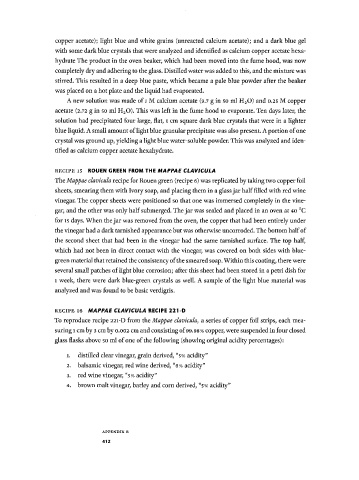Page 429 - Copper and Bronze in Art: Corrosion, Colorants, Getty Museum Conservation, By David Scott
P. 429
copper acetate); light blue and white grains (unreacted calcium acetate); and a dark blue gel
with some dark blue crystals that were analyzed and identified as calcium copper acetate hexa-
hydrate The product in the oven beaker, which had been moved into the fume hood, was now
completely dry and adhering to the glass. Distilled water was added to this, and the mixture was
stirred. This resulted in a deep blue paste, which became a pale blue powder after the beaker
was placed on a hot plate and the liquid had evaporated.
A new solution was made of ι M calcium acetate (9.7 g in 50 ml H 2 0 ) and 0.25 M copper
acetate (2.72 g in 50 ml H 2 0 ) . This was left in the fume hood to evaporate. Ten days later, the
solution had precipitated four large, flat, 1 cm square dark blue crystals that were in a lighter
blue liquid. A small amount of light blue granular precipitate was also present. A portion of one
crystal was ground up, yielding a light blue water-soluble powder. This was analyzed and iden
tified as calcium copper acetate hexahydrate.
RECIPE 15 ROUEN GREEN FROM THE MAPPAE CLAVICULA
The Mappae clavicula recipe for Rouen green (recipe 6) was replicated by taking two copper foil
sheets, smearing them with Ivory soap, and placing them in a glass jar half filled with red wine
vinegar. The copper sheets were positioned so that one was immersed completely in the vine
gar, and the other was only half submerged. The jar was sealed and placed in an oven at 40 °C
for 15 days. When the jar was removed from the oven, the copper that had been entirely under
the vinegar had a dark tarnished appearance but was otherwise uncorroded. The bottom half of
the second sheet that had been in the vinegar had the same tarnished surface. The top half,
which had not been in direct contact with the vinegar, was covered on both sides with blue-
green material that retained the consistency of the smeared soap. Within this coating, there were
several small patches of light blue corrosion; after this sheet had been stored in a petri dish for
1 week, there were dark blue-green crystals as well. A sample of the light blue material was
analyzed and was found to be basic verdigris.
RECIPE 16 MAPPAE CLAVICULA RECIPE 221 -D
To reproduce recipe 221-D from the Mappae clavicula, a series of copper foil strips, each mea
suring 1 cm by 3 cm by 0.002 cm and consisting of 99.98% copper, were suspended in four closed
glass flasks above 50 ml of one of the following (showing original acidity percentages) :
1. distilled clear vinegar, grain derived, "5% acidity"
2. balsamic vinegar, red wine derived, "6% acidity"
3. red wine vinegar, "5% acidity"
4. brown malt vinegar, barley and corn derived, "5% acidity"
A P P E N D I X Β
412

